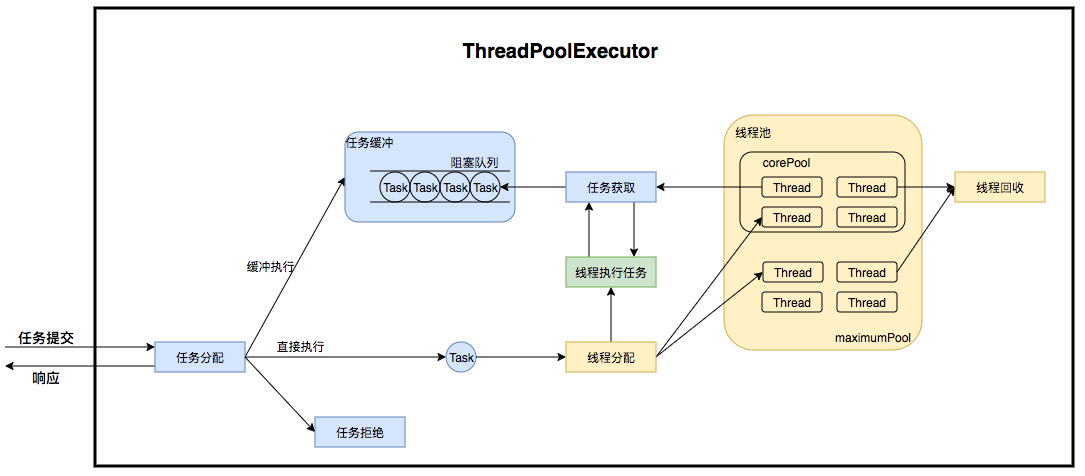Java Thread
java 多线程
多线程的创建
- 继承Thread类【不建议】
- 继承Thread类
- 重写run方法
1 | class MyThread extends Thread{ |
- 实现Runnable【推荐】
- implements Runnable
- 重写run方法
- 传进Thread()中
1 | public class RunnableDemo { |
- 实现Callable
- 实现Callable,重写call方法
- 创建线程池,Executors.newCachedThreadPool()
- submint
- shutdown
1 | public class CallableDemo { |
静态代理
总的来说:
- 真实对象 和 代理对象 都要实现同一个接口;
- 代理对象 要代理 真实对象
特点:
- 代理对象能做很多真实对象不能做的事情
- 真实对象专注完成自己的
通过Runnable实现多线程,就使用了静态代理【new Thread(new MyRunnable))】
线程状态(6个)
- new 【新建】
- running 【可运行】
- blocked 【阻塞】
- waiting 【等待】
- timed waiting 【定时等待】
- terminated 【死亡】
获取线程状态方法,Thread.getState();
线程停止的方法
- 正常停止
- 利用标志位停止
Tread中的部分方法
- void join() — 等待终止指定的线程
【插队】
1 | public class DemoJoin { |
void join(long millis) — 等待指定的线程终止 或 等待经过指定秒数
Thread.State getState() — 线程状态
void stop() — 停止该线程(已废弃)
void suspend() — 暂停这个线程的执行(已废弃)
void resume() — 恢复线程(已废弃)
static void yield() — 静态方法,交出运行权
yield—【礼让】
虽然交出了运行资源,但是下个运行线程还是要看 **CPU ** 调度
线程状态转化
New ---> Runnable
调用start()方法,进入Runnable,等待cup时间片
一个线程不能重复调用start()即,线程死亡之后不可重复调用【start方法中有检测线程状态】
start()方法源码
1
2
3
4
5
6
7
8
9
10
11
12
13
14
15
16
17
18
19
20public synchronized void start() {
if (threadStatus != 0)
throw new IllegalThreadStateException();
group.add(this);
boolean started = false;
try {
start0();
started = true;
} finally {
try {
if (!started) {
group.threadStartFailed(this);
}
} catch (Throwable ignore) {
}
}
}
blocked
- 试图获得锁,会进入blocked
守护线程daemon
Thread.setDaemon();
每个程序都有守护线程如gc等
jvm不需要等待守护线程的结束,就可以退出了
中断线程
void interrupt() — 向线程发送中断请求,线程的中断状态设置为true(默认false)
static boolean interrupted() — 测试当前线程是否被中断,会将中断状态设置重置为false
boolean isInterrupted() — 测试线程是否被中断
static Thread currentThread() — 返回当前正在执行的线程Thread对象
进程间的通信方式
- 锁和同步
- 等待/通知机制
- 信号量
- 管道
- 其它方法:
- join()
- sleep()
- ThreadLocal类
线程池
重要的类和接口
类 用途 ExecutorService 真正实现线程池的接口 ScheduledExecutorService 能和Timer/TimerTask类似,解决那些需要任务重复执行的问题。 ThreadPoolExecutor ExecutorService的默认实现。 ScheduledThreadPoolExecutor 继承ThreadPoolExecutor的ScheduledExecutorService接口实现,周期性任务调度的类实现
Executor—-接口
1 | public interface Executor { |
Executors — 提供静态工厂方法用于创建各种线程池的类
1 | public class Executors { |
ExecutorsService — 线程池定义的接口,继承Excutor,用于线程的操作【shutdown】
1 | public interface ExecutorService extends Executor { |
ThreadPoolExecutor
ThreadPoolExecutor 是ExecutorService的默认实现
构造方法中参数介绍
- corePoolSize : 核心池的大小
- maximumPoolSize : 线程池最大线程数
- keepAliveTime : 表示线程没有任务执行时最多保持多久时间会终止
- unit : 参数keepAliveTime的时间单位
- workQueue : 一个阻塞队列,用来存储等待执行的任务
- threadFactory : 线程工厂,主要用来创建线程;
- handler : 表示当拒绝处理任务时的策略
- ThreadPoolExecutor.AbortPolicy:丢弃任务并抛出RejectedExecutionException异常。
- ThreadPoolExecutor.DiscardPolicy:也是丢弃任务,但是不抛出异常。
- ThreadPoolExecutor.DiscardOldestPolicy:丢弃队列最前面的任务,然后重新尝试执行任务(重复此过程)
- ThreadPoolExecutor.CallerRunsPolicy:由调用线程处理该任务
1 | //只取了ThreadPoolExecutor的四个构造方法 |
实例创建线程池
newCachedThreadPool – 创建一个可缓存的线程池,若线程数超过处理所需,缓存一段时间后会回收,若线程数不够,则新建线程
1 | public class PoolDemo { |
newFixedThreadPool — 创建一个固定大小的线程池,可控制并发的线程数,超出的线程会在队列中等待
1 | class FixedThreadDemo{ |
newSingleThreadPool – 创建一个单线程的线程池,可保证所有任务按照指定顺序(FIFO, LIFO, 优先级)执行
1 | class SingleThreadDemo{ |
newScheduledThreadPool – 创建一个周期性的线程池,支持定时及周期性执行任务
1 | class ScheduledThreadDemo{ |
ThreadPoolExecutor – 【推荐使用,根据需求创建合适的线程池】
1 | class ThreadPoolExecutorDemo{ |
重要知识点
使用线程池的好处
- 降低资源消耗:通过池化的技术重复利用被创建的线程,降低线程创建和销毁造成的开销
- 提高响应速度:当任务到达时,无需等待线程创建即可立即执行
- 提高线程的可管理性:线程是稀缺资源,如果无限制创建,不仅会消耗系统资源,还会因为线程的不合理分布导致资源调度失衡,降低系统的稳定性。使用线程池可以进行统一的分配、调优和监控。
- 提供更强大的功能:线程池具备可拓展性,允许开发人员向其中增加更多的功能
线程池解决的核心问题
线程池解决的核心问题就是资源管理问题
在并法的环境下,系统不确定在任意时刻中,有多少任务需要执行,有多少资源需要投入。这样的不去确定性会带来问题:
- 频繁申请/销毁资源和调度资源,将带来额外的消耗,可能会非常巨大。
- 对资源无限申请缺少抑制手段,易引发系统资源耗尽的风险。
- 系统无法合理管理内部的资源分布,会降低系统的稳定性。
为解决资源分配这个问题,线程池采用了“池化”(Pooling)思想
ThreadPoolExecutor是如何运行
线程池的运行主要分成两部分:任务管理、线程管理。

生命周期管理
线程池内使用一个变量维护两个变量:运行状态(runState)和线程数量 (workerCount–有效线程数)
线程池有五种状态:
- RUNNING – 能接收新提交的任务,也可以处理阻塞队列的任务
- SHUTDOWN – 关闭状态,不可以接收新的任务,但是可以继续处理阻塞队列的任务
- STOP – 不接收新的任务,也不处理阻塞队列中的任务,会中断正在处理任务的线程
- TIDYING – 所有任务都终止了,workerCount(有效线程数)为 0
- TERMINATED – 在terminated()方法之后进入这个状态
生命周期的转化

任务调度
所有任务的调度都是由execute方法完成的
执行过程如下:
- 首先检查线程池的状态,如果不是Running,直接拒绝执行
- 如果workerCount < corePoolSize ,则创建并启动一个线程来执行该任务
- 如果workerCount >= corePoolSize && 阻塞队列未满,则将该任务放入阻塞队列中
- 如果workerCount >= corePoolSize && workerCount < maximumPoolSize ,且阻塞队列已满,则创建并启动一个线程来执行该任务
- 如果workerCount >= maximumPoolSize ,并且线程池内的阻塞队列已满,则根据拒绝策略来处理该任务, 默认的处理方式是直接抛异常
拒绝策略
当线程数量大于maximumPoolSize,就会执行拒绝策略。ThreadPoolExecutor类中一共有4种拒绝策略。
通过实现RejectedExecutionHandler接口。
- AbortPolicy【终止策略】 : 线程任务丢弃报错。默认饱和策略。
- DiscardPolicy 【丢弃策略】: 线程任务直接丢弃不报错。
- DiscardOldestPolicy 【丢弃阻塞队列中的最老策略】: 将workQueue队首任务丢弃,将最新线程任务重新加入队列执行。
- CallerRunsPolicy 【直接调用run方法】:线程池之外的线程直接调用run方法执行。